

© Shipping Wonders of the World 2012-

The River Niger
The conquest of the River Niger was effected only after many years of exploration, hardship and tragedy in the face of almost insuperable dangers
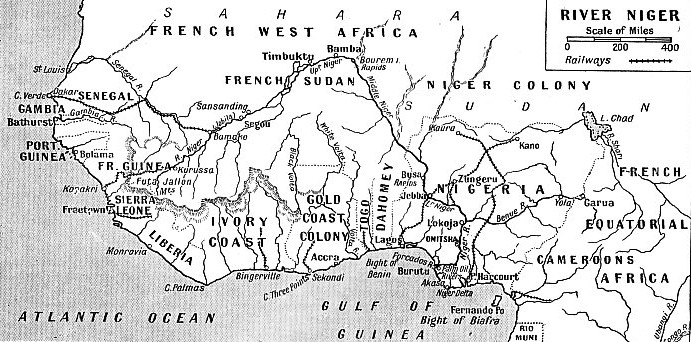
FROM SOURCE TO DELTA the River Niger covers a distance of some 2,600 miles. Its source in the Futa Jallon Mountains is only 200 miles from the coast of Sierra Leone. Numerous tributaries join the river above Timbuktu, and below Bourem Island there is a series of rapids. At Lokoja is the confluence with the Benue River. The Niger joins the sea through a delta in which the various streams are called the Palm Oil Rivers.
ALTHOUGH the rivers of Africa are among the longest in the world, they are not navigable by ocean-
In many ways the Niger is remarkable and the story of its conquest is no less noteworthy. Britons, sometimes single-
The head waters of the Niger rise in the Futa Jallon Mountains on the borders of Sierra Leone within 200 miles of the sea. The slope of the mountains prevents the river from flowing south into the Atlantic, and north of them stretch the thirsty sands of the Sahara, one of the most arid regions in the world. After their descent from the mountains the various streams flow north-
The river turns south-
North of the Niger there is no important river between it and the Mediterranean. To the west is the Senegal River and the Gambia River is south of that. A number of smaller rivers drain the territory south of the Niger basin and flow into the Gulf of Guinea. Though the country north of the river is arid, that to the south has a high rainfall.
Because of rapids and the great difference in the level of the river between the high-
In recent years passages have been blasted through some of these barriers, and the flow of the river is gradually becoming more continuous. Irrigation schemes are being introduced in the French Sudan and a dam is being built to impound the waters and divert them into irrigation canals to further the growing of cotton. Formerly vast areas were swamped by the water which comes down from the mountains, and these floods are being controlled.
There are three sections of the river. The Upper Niger extends from the source to Bourem Island, some 200 miles below Timbuktu. The Middle Niger extends from this point to Jebba, in Nigeria, below the dangerous Busa Rapids. The Lower Niger is from Jebba to the sea. The streams which flow through the delta are known as the Palm Oil Rivers. Some are branches of the Niger, but those to the east are not connected with it. To the west of the Niger delta are other rivers and long coastal lagoons.
This swampy area extends from Dahomey along the coast of Nigeria to the Cameroons, where the character of the coast changes and mountains thousands of feet high form an effective barrier to the South Atlantic and turn the coast-
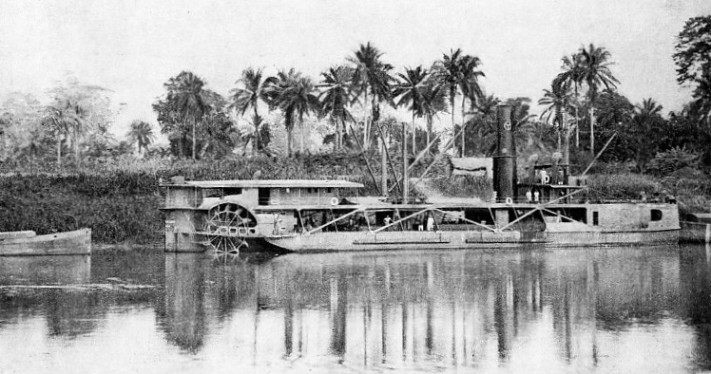
A PLACID REACH OF THE NIGER fringed with the palm trees on which depends the palm oil industry of the Niger delta. Moored to the bank is the stern-
The long coast of the Gulf of Guinea was for centuries the haunt of slavers, who picked up their black cargoes and sailed them across the Atlantic to the New World. The Niger, however, which flows in a horse-
The conquest of the Niger by explorers and the opening up of commerce by traders were made possible by the use of steamboats. As the fruit of the labours of the British pioneers, the vast country called Nigeria has become a British colony and protectorate. It may seem strange that the Niger remained unknown for centuries after white men had traversed the courses of rivers such as the Amazon in South America, but the secrets of the Niger were inviolate. Almost insuperable dangers killed the men who tried to draw the veil aside. The savages and the disease-
Not until Sir Joseph Banks, the scientist who accompanied Captain Cook on his first voyage round the world, formed the African Association in 1788 was a determined attempt made to solve the riddle of the Niger. The Association sent John Ledyard to Egypt with orders to go south-
Pioneering Work of Mungo Park
Then a fourth man, a young Scottish surgeon who had been employed in one of the East India Company’s ships, took up the quest. He was Mungo Park. He went to the Gambia in 1795, learnt a smattering of a native language while recovering from the inevitable attack of fever, and then struck inland with only a few servants. He managed to get past the pagan country, but the Mohammedan tribesmen seized him. He was maltreated and was robbed of everything except his pocket compass. He escaped and nearly died in the desert, but eventually struggled through to an inhabited region. Alone, Park wandered steadily towards his goal in such a state that even slaves were ashamed to be seen in his company. At last he came to the river at Segou. “I saw”, he wrote, “with infinite pleasure the great object of my mission, the long-
He followed the river to Sansanding and went towards Timbuktu, but turned back when he heard that the Moors, who had treated him so badly elsewhere, held the city. He fell in with a Negro slave merchant who helped him to the British post on the Gambia. There was no direct service to England and Park had to sail to the West Indies to get another vessel to take him to England, where he arrived late in 1797.
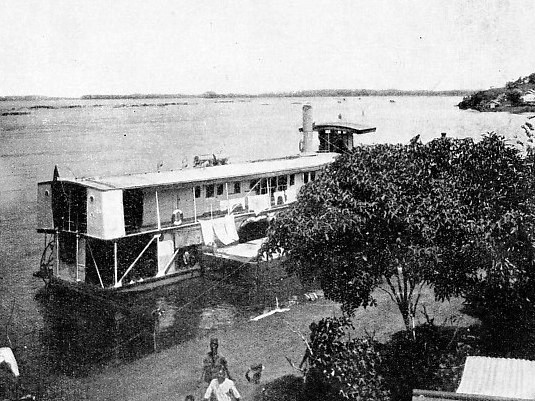
IN SOUTHERN NIGERIA the Niger is navigable for more than 400 miles from the sea. This photograph shows the 135-
Park’s discovery gave the first reliable information about the mysterious river. Park married and set up in practice at Peebles, Scotland, but the spell of the river was upon him. He told Sir Walter Scott, one of his friends, that he would rather endure the horrors of Africa than wear out his life at home. Park accepted the offer to command a Government expedition to the Gambia in 1805.
He set out for the Niger with forty-
The survivors were Park, Lieutenant Martin and three soldiers, one of whom had gone mad. Despite all he had endured Park was as determined as ever and he wrote a letter home saying, “I shall set sail to the east with the fixed resolution to discover the termination of the Niger, or perish in the attempt”. These were fateful words.
Having sent letters to the coast by his native guide, Isaaco, Park built a boat which he called the Joliba, after the local name of the Niger, meaning “the fastest runner”. With one man crazy and the other Europeans feeble with fever, Park determined to keep to the boat. He engaged a guide named Amadi and three slaves as paddlers.
About a year after the Joliba had left Sansanding rumours reached the coast that all the Europeans had perished, but that the guide Amadi was a prisoner up country. Park’s faithful guide Isaaco later found Amadi in the interior.
The story of the tragedy was pieced together. It appears that the Joliba passed Timbuktu and made a journey of over 1,000 miles into what is now Nigeria. Amadi left the craft and was seized by a native chief. The canoe passed Busa and approached the rapids below it. Here the river is checked by two islands and flows past them in three channels, only one of which is passable, the others being death-
Park’s death in 1806 added to the mystery of the river. He died believing that it led to the Congo, and there was controversy as to whether he was right or wrong. Other explorers went out, most of them to perish. There were twenty years of repeated failure until it seemed that the attempt to solve the riddle was a painful and protracted method of suicide. The long sequence of disaster was changed by an expedition which failed to solve the riddle, but brought new facts to light. This expedition, led by Major Denham, Captain Clapperton and Dr. Oudncy, set out from Tripoli, crossed the Sahara and came out at Nigeria. Dr. Oudney died, and the survivors returned to England. Later Clapperton made another expedition from the Bight of Benin and reached Busa, the scene of Park’s disaster. He went farther only to die. His servant, Richard Lander returned to England. The riddle of the Lower Niger was even yet unsolved, but Lander was sure he had the clue.
He pressed the Government to send him out, but received meagre aid. His brother John, whom the Government refused to pay, decided to accompany him. The two went up country to Busa, where they secured relics of Park. After many adventures the brothers reached the sea in two canoes. At last the secret was discovered.
Exploration in Paddle Steamers
The account of their adventures fired the enthusiasm of Macgregor Laird, a Liverpool merchant who was the son of the founder of the shipbuilding firm of William Laird and Son, Birkenhead. Although Macgregor Laird spent most of his fortune in opening the Niger to steam navigation and paving the way for the development of the country, he died before the fruits of his labours ripened. The Government was not interested in Lander, but Laird took him up and decided to head an expedition to the river.
Two iron-
The two vessels began to explore the maze of creeks in the delta, using the island of Fernando Po as a sea base. Laird later returned to England, while the two vessels made several trips up the river. Eventually the ravages of the climate compelled a halt. Lander perished, but not of fever. He was fatally wounded in an encounter with the natives. Only nine of the forty-
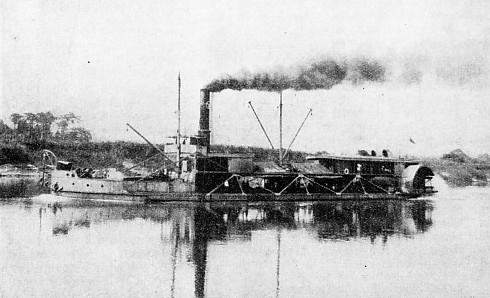
THE LOWER NIGER is safe for navigation as far as Jebba, 433 nautical miles up the river. The Scarbrough is typical of the stern-
A little later an adventurous mariner named Beecroft, who had made Fernando Po his headquarters and become an agent there and afterwards governor, made some successful exploring trips up the Niger. The account of his explorations aroused the philanthropists who wanted to stamp out the slave trade. Money was subscribed by the public and Government funds were voted for an ambitious expedition to open up the river and induce the natives to stop the traffic in slaves.
Three steamers, the Albert, the Soudan and the Wilberforce, sailed from England in 1841 with 145 Europeans, including captains in the Royal Navy, naval surgeons, missionaries, a botanist, a geologist, mineralogists and naturalists. Nothing seems to have been forgotten, and there were respirators for the men to wear if they had to come on deck at night when the river mist was rising. The Victorians blamed the mist and not the mosquito for their casualties. There were also farm implements for the model farm where reformed slave traders were to be taught farming.
Unfortunately, the ships put in at so many ports to keep up their fuel supplies that they did not reach the delta until the middle of August, when the climate was almost at its deadliest. The expedition proceeded according to plan, despite the deaths that began immediately. Commander Allen, who had been on Laird’s expedition, urged a withdrawal to sea, but was overruled. Later, two of the steamers returned to the coast and the third went upstream until every officer was down with fever.
Then only did she turn back. Some of the fever-
Years later three explorers went overland from Tripoli and reached Lake Chad. Two died, but Barth, the third, sent news of his work on the upper waters of the Benue, and people wondered if this was the river that flowed into the Niger. The watchful Macgregor Laird suggested building a special vessel to send up the Niger and then up the Benue to try to rescue Barth. A contract was therefore arranged between Laird and the Government. Laird undertook to plan and equip the expedition but the trading profits were to be his. He was granted £5,000, and it was arranged that the vessel should proceed to Fernando Po, where Beecroft would join her as commander.
An interesting vessel named the Pleiad was built by John Laird. She was an auxiliary with a lifting propeller, and is said to have been the first exploring vessel to have been fitted with a propeller. Her length was 105 feet and her beam 24 feet. She had a 40-
The Pleiad was schooner rigged and the lifting propeller prevented the screw from retarding her speed under sail. This was before coaling stations were established on the route, and the vessel was intended to carry her coal from England under sail and to reserve it for use on the Niger.
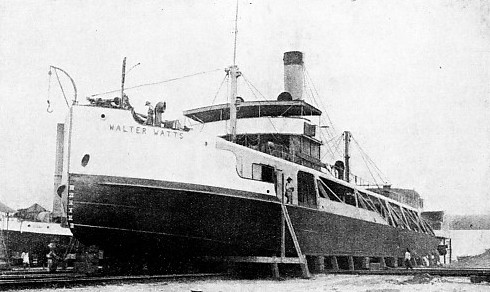
ON THE SLIPWAYS, of which there are three on the Niger, all river vessels are repaired. Many of them are built in Great Britain, sent out in sections and assembled on the Niger slipways. The Walter Watts is one of the largest cargo steamers on the river. Of 400 tons gross and built in 1922 she is a twin stern-
Thanks to Laird’s forethought on all points she did well. Knowing the climate by experience, he insisted on keeping the number of Europeans to the minimum. The Pleiad left under the command of Dr. William Balfour Baikie, R.N., who dosed the ship’s company with quinine night and morning. When she reached Fernando Po, Dr. Baikie learned that Beecroft had died. Baikie decided to go up the river. He had engine trouble and the Pleiad ran aground several times, but he reached the confluence of the Niger and the Benue. Baikie ascended the Benue farther than any white man before him. Unfortunately the river began to fall. Baikie left the little vessel and went on farther by canoe until he was sure that Barth was not in the district. Then he returned to the Pleiad.
He traded her cargo, and she sailed back to England without the loss of a man by disease or accident, a new and wonderful event in the story of the Niger. He established that the river which Barth had reached was the one which flowed into the Niger. The trading profits did not cover Laird’s expenses, but the Government indemnified him. It gave him a contract to place a steamer on the Niger with a yearly subsidy on condition that she carried passengers nominated by the Government. The Government was urged to send a vessel on another expedition, and Dr. Baikie was selected to command.
The Dayspring was built by John Laird. She Was an auxiliary yawl, with a length of 76 ft. 3 in., a beam of 22 feet and a draught of 5 ft. 8 in. An engine of 30 horse-
Accompanied by the schooner George she went into the Niger. On board her was Lieutenant, afterwards Sir John, Glover, who was to play a prominent part in the development of the country.
Traders’ Hostility
The Dayspring went up to the confluence of the Niger and the Benue and followed the Niger. She was wrecked on a rock near Jebba. The fierce current mastered her engine and hurled her against the rock, holing her so that she sank bows first. When the river level fell the men examined her, but she was past repair. Laird sent out two new steam vessels, the Sunbeam and the Rainbow. The Sunbeam was designed to go up the river to the trading posts that Laird’s agents had established. She drew only 4 feet and one of her first jobs was to rescue the crew of the unlucky Dayspring. Laird’s enterprise was watched with jealous eyes by the white captains and supercargoes who were in the delta region. His success would spoil the slave trade which, although forbidden, still existed, and would also cut into the huge profits then made out of palm oil.
The trading ships in the Palm Oil Rivers, as the region was called, were run by mixed characters. The white men housed the decks in with bamboo mats in a vain effort to check the mosquitoes and sandflies. The reek of the mangrove swamp and the smell of palm oil was ever in their nostrils. For those who survived the profits were huge. A supercargo could make thousands of pounds in a successful season, provided he did not die of fever or drink himself to death.
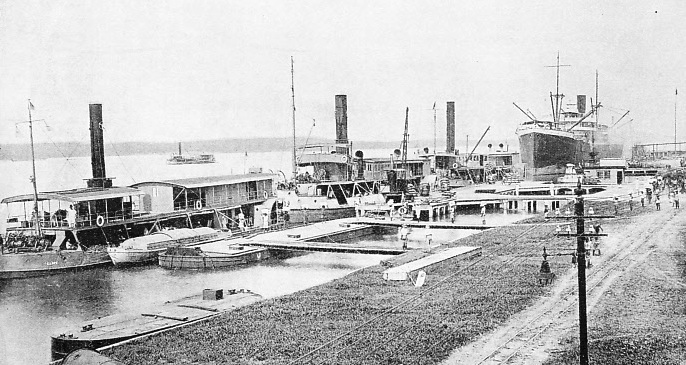
THE PORT OF BURUTU is one of the newest African ports. After a disastrous fire in 1917, the port was rebuilt with 1,000 feet of concrete wharves fronting the Niger. Burutu is a port of shipment for palm oil. In the photograph above are the river steamers Kampe (105 tons gross), Richard Lander (220 tons gross) and Taraba (319 tons gross). The Kampe is 117 feet long, 24 feet in beam and 5 feet deep. She is used on the weekly mail and passenger service between Burutu, Warri and Baro. She draws 2 ft. 4 in. of water in light running condition and carries about 90 tons of cargo in addition to more than 130 passengers.
Winged and crawling insects tormented all. Water-
Almost at the same time the chief of Lagos ceded his territory to the British Government. British traders became more numerous and a man arose to continue the work started by Laird. He was Goldie Taubman, afterwards Sir George Taubman Goldie. His intention, on arrival in the country, accompanied by his brother, was to go up the Benue as far as possible in a steam launch and then to travel overland to the Nile.
A launch was sent out from England in sections and put together, but the brother became ill and the project was abandoned. While on the river, Goldie saw its possibilities and he succeeded in amalgamating the trading firms into a company from which sprang in later years the Royal Niger Company.
When, in 1900, the Royal Niger Company territory passed to the Crown the company continued in another form as a trading concern. The work is to-
Ocean steamships and a fleet of river craft maintained by the United Africa Company link the river with Great Britain. At one time the headquarters were at Akasa, on the coast, but these have since been removed to Burutu, on the Forcados River, where the workshops and principal wharves and stores are situated.
The ocean ships of the fleet are thirteen in number and average 5,200 tons gross. They include such vessels as the Ashantian, Gambian, Liberian, Nigerian and Matadian. These ships proceed to Burutu from England and load the produce brought down the Niger and the Benue from the up-
The river steamers go up the Niger past Lokoja to Jebba, the limit of safe navigation on the Lower Niger, 433 nautical miles from the sea. Other craft turn up the Benue at the confluence at Lokoja and, when the river is high enough, get up hundreds of miles through Nigeria and into the Cameroons, the limit of navigation being at Garua.
River Boats Assembled Locally
As a rule the river boats are built in sections in Great Britain and sent to Burutu, where the sections are assembled and the engines are installed. Some of the larger craft have, however, gone to Nigeria under their own steam. There are three slipways where vessels are assembled and repaired. All steamers and barges are built of steel. One of the largest vessels of the river fleet is the twin stern-
Various other craft are either stern-
Each large craft can tow two steel barges, one on either side of her. About 1,200 tons of cargo distributed between the three craft are carried on a draught of about 7 ft. 6 in. The smaller craft, with two barges alongside, carry about 600 tons on a draught of 6 feet. As the channels are intricate the method of towing the barges alongside is preferable to towing them in line ahead.
The stern-
The port of Burutu is situated on a branch of the Forcados River in the Niger delta. Reclamation and drainage have converted pestilential swamps into a healthy transport station. Burutu to-
Port Harcourt, on the Bonny River, has been developed in recent years as the terminal of a section of the railways. Lagos, the capital city, on the Lagos Lagoon, is another port where ocean ships collect the produce brought from up-
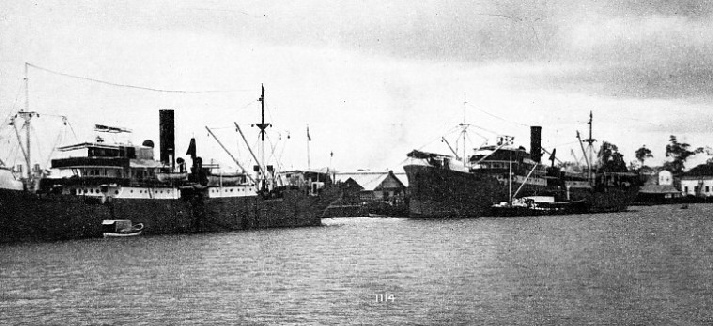
A WHARF AT WARRI in Southern Nigeria. Alongside are two steamers of John Holt and Company, the Jonathan C. Holt (2,921 tons gross), in the foreground, and the Thomas Holt (3,580 tons gross). The former vessel, built at Middlesbrough in 1926, has a length of 310 feet between perpendiculars, a beam of 44 ft. 7 in. and a moulded depth of 26 ft. 4 in. The Thomas Holt, built at Birkenhead in 1929, has a length of 330 ft. 6 in., a beam of 47 ft. 1 in. and a moulded depth of 27 ft. 6 in., with a corresponding draught of 20 ft. 4 in.
You can read more on “Filling the Ship”, “The Nile” and “The River Congo” on this website.